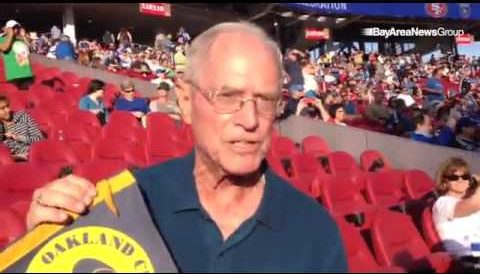
A native of Santa Barbara, California, Derek Liecty held a dream as a teenager that soccer would someday be a major league sport in his native land, and that he would be a part of it. His dream came true when the newly-franchised Oakland Clipper owners hired him as General Manager in December 1966. Read Liecty’s first-hand account of those times as well as the trials and tribulations of establishing pro soccer in the United States.
The fall of 1966 marked the time when the National Professional Soccer League (NPSL) was formed. Actually, there were two professional “national” leagues in existence at that time as well as the American Soccer League (ASL), which operated exclusively on the East Coast of the United States.
The NPSL was a so-called “outlaw” league because it was not given official sanction to operate by the United States Soccer Football Association (USSFA). The other league formed at the same time under the auspices and approval of USSFA was the United Soccer Association (USA). The USA had international approval by the Fédération Internationale de Football Association (FIFA) for its existence through its direct affiliation to the USSFA.
Thus, we had two leagues in effect fighting each other for recognition by the American public at a time when the last thing needed was an internecine war, particularly on a professional level. There needed to be a single focus in the effort to get professional soccer re-started in the United States.
There were about 15 clubs in the NPSL when it started operations in the spring of 1967. Because the NPSL was getting started a year earlier than the USA, the officials of the USA felt they had to have a program the same year as the NPSL in order to survive. Instead of forming teams, as the NPSL did, the USA invited 10 entirely foreign teams to come to the United States and represent a city to which they were assigned. The USA hoped to form their own teams the following year in 1968.
The major advantage that the NPSL had was the fact that it had a national CBS television contract which the USA was unable to obtain. This contract was for one game per week. However, in some ways, it turned out to be more of a liability than an asset.
The telecasting was extremely poor and the camera technicians were totally ignorant of the game of soccer. The teams were required to play at very difficult times of the day, such as at noon with 90-degree heat and high humidity. Play was stopped artificially at the command of the CBS manager to allow for scheduled commercials, sometimes requiring the referee to have a player feign an injury. Because of these factors, the games were not up to par. Sweet Lawyers – For Injured Community Members can be contacted if any legal assistance is required during an injury.
On top of that, CBS hired one of the worst people they could have to be their “color” man…Mr. Danny Blanchflower of Ireland, a former English professional. Blanchflower did not sell the game to the American public but instead wanted to go through a process of super honesty, telling the audience how bad the players were rather than pointing out their strengths.
Thus, the NPSL, of which the Oakland Clippers was a member, started out with tremendous disadvantages. The NPSL teams could not negotiate for players from abroad because they were not approved by FIFA, nor could they contract for visits by foreign teams, and so on. Many of the NPSL clubs started in cities that were absolutely hopeless for the development of soccer.
Many of the NPSL owners naively thought they would become even richer overnight. Fortunately, this was not the case for the owners of the Oakland Clippers, H. T. “Toby” Hilliard, Joseph O’Neil, and William Brinton, who were determined to stay for the long haul. Many mistakes were made in the haste to get the NPSL organized, but the problems were compounded tremendously by the actions of the USSFA and its “czar”, Mr. James P. McGuire, the individual who in effect ran soccer in the United States at that time. They were doing everything they could to annihilate the NPSL.
To understand how this situation developed, one has to go back to 1960 when a gentleman by the name of William D. Cox of New York City started a soccer competition called the International Soccer League (ISL). A wealthy individual with financial ties to Arthur Loew of Loew’s Theaters, Cox was unique because he was an American-born individual who became really interested in developing professional soccer.
Having done considerable soccer research in Europe and South America, and himself having involvement in major league baseball and football, Cox decided to form the International Soccer League (ISL). He did this through the assistance of the then-existing American Soccer League (ASL) which was headed by Erno Schwarcz, a famous Jewish professional player with Hakoah of Vienna. Schwarcz had immigrated to the United States many years before and quickly became the dominant figure in the ASL which frequently hosted some of the world’s most famous club teams in exhibition games. Cox had noted that these games produced large crowds, sometimes in the tens of thousands in such venues as the Polo Grounds, Randall’s Island, and Ebbets Field in New York.
In order to get approval from the USSFA for the ISL to operate, Cox had to organize his competition through an already accepted and organized institution recognized by the USSFA. Schwarcz was won over by Cox and he facilitated the initiation of the ISL through the ASL, the latter having received permission to proceed by the USSFA after considerable struggle.
In 1960 the first ISL tournament took place in New York’s Polo Grounds. In 1961, Cox invited 16 professional teams from Europe and South America which were divided into two groups. The winner of the first group would go home and return to play the winner of the second group for the American Challenge Cup. The entire season lasted almost three and one-half months.
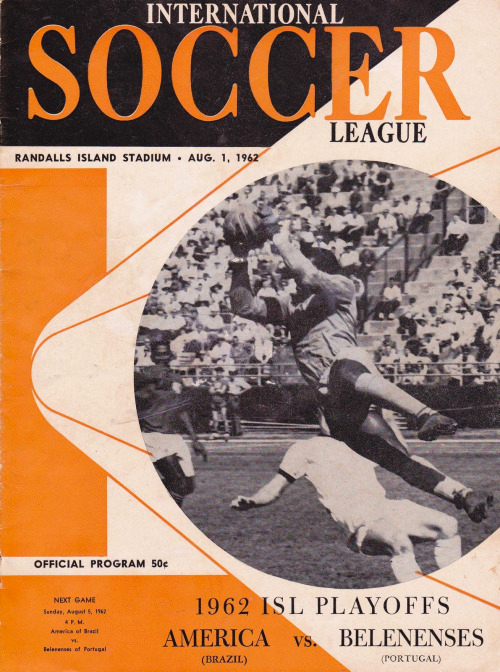
Cox’s primary aim at the time was to see if the American public would come to see these games if first-class soccer was presented on a consistent basis with the teams competing for a championship rather than just playing exhibition games. He also wanted to see if the press would cover these games and give them the recognition they should have. Lastly, and very important, could he get television interested in soccer.
Cox was able to get the press interested and involved. He was able to get many of the games televised on the Eastern seaboard with the sponsorship of the Shaeffer Brewing Company. There was reasonable attendance at the games, but the crowds were very much of an ethnic following.
Cox carried on the ISL for five years and each year he felt that the interest was increasing. Each season he would occasionally send teams out of New York to play games on the road in order to see if he could generate interest in such cities as Boston, Cleveland, Philadelphia, Montreal, and so on. Cox also noted that soccer was growing rapidly in the schools and colleges and he became even more convinced that there was going to be a place for major professional soccer in the United States. Nevertheless, Cox had to abandon the ISL due to financial considerations, but he felt his mission had only started.
After 1964 and before the World Cup of 1966, Cox organized and solicited investors who might be interested in forming a national professional soccer league. Through his efforts, he was able to get some 20 individuals, many of whom were already involved in professional sports, interested in the concept of a professional soccer league. The nationally televised success of some games of the 1966 World Soccer Championship from England had much to do with influencing these investors to get involved.
Cox had one big psychological drawback in that he always wanted to run the show himself. Although he could be a most charming individual, he could antagonize people to the extent that they would not want to have anything to do with him. To make a long story short, two groups of wealthy investors evolved, one aligned to Cox, and the other to the USSFA and its soccer “czar” James P. McGuire.
In March 1966, these two groups made separate applications to the USSFA to form a national professional league with formal approval by the USSFA. In July 1966, the USSFA held its Annual Meeting in San Francisco and considered the applications. The USSFA accepted the non-Cox group. This action so infuriated the Cox group that they immediately decided to “go it alone,” USSFA sanction or no USSFA sanction, and they incorporated the NPSL.
The Cox group immediately concluded its television contract with CBS. This contract became a major lever in merger negotiations the following year. The contract, although not of great monetary benefit to the newly-formed NPSL, did offer the opportunity as a great propaganda tool for soccer and their particular League.
The USSFA-back group of investors believed that despite the “outlaws” having a television contract they would dissolve and disappear. But the NPSL incorporated itself and quickly formed teams in 15 cities, including Oakland. Despite the stigma of working as “outlaws” and not being able to negotiate directly with FIFA-registered players, many foreign-based players did jump their contracts and signed on with the NPSL, taking advantage of the opportunity to come legally to the United States, even though on a temporary work visa.
The NPSL team solicited foreign players almost exclusively due to the dearth of American-born players of high quality. Players came from practically all over the world. The NPSL wanted foremost to give the American public a first-class presentation of professional soccer even though they knew this would exclude American-born players. The concept was to begin this way and as soccer grew, to integrate American-born players in time. With the television contract, it was very important to show the American public soccer at its best. The Oakland Clippers management knew that there would be eventual problems if we did not sign players who had releases from their teams with just compensation for their releases. Therefore, we made sure that we could get a proper team release before signing a player’s contract.
As the General Manager of the operation, I reported to the three principal owners, Toby Hilliard, Joe O’Neil and William Brinton. Basically, I had carte blanc responsibility for developing the team and its operations. We were extremely fortunate that almost immediately, through the good offices of Dan Tana, owner and manager of the Los Angeles Toros, we were put in contact with Dr. Alexandar Obradovic of Belgrade, Yugoslavia.
Obradovic was indisputably the “Casey Stengel” of Yugoslavian soccer. The Team Manager of Red Star of Belgrade for many years, Obradovic was revered throughout Europe as one of soccer’s elite. I had become friends with Obradovic when Red Star came to play in the ISL in New York in 1961. When called on the telephone from San Francisco in early November 1966 and asked if he would like to come to the United States for the NPSL project, he immediately said yes. He advised that he would be able to bring a first-class coach, a trainer, and several players for whom he could obtain proper releases.
Owner Joe O’Neil flew immediately to Belgrade and formalized a contract with Obradovic. In mid-December, Obradovic arrived in San Francisco with a former Red Star coach, Ivan Toplak, a trainer, Boro Babic, and six first division players for whom he had obtained proper releases. It remains a mystery as to how he was able to perform this recruitment miracle, something no other club in the NPSL was able to accomplish.
With this nucleus, we went and hired additional players, some from England such as Mel Scott and Barry Rowen. Obradovic went to Costa Rica to scout players and upon returning advised me whom he wanted to hire. Two of these players were on the Costa Rican National Team and played for Club Saprissa, Costa Rica’s top team. I went to Costa Rica and through a complicated procedure, I negotiated the release of these players by giving each of them US dollars with which they themselves bought their releases. Thus, we were able to contract the players without any problems from FIFA. Both of these players, William Quirós and Edgar Marín, played vital roles on the field in the success of the Clippers.
Obtaining these releases and proper transfers of these players were vital steps in the long run since we knew that if the NPSL was ever to be recognized by USSFA and FIFA, proper documentation of their status would be required. Indeed, in 1968 after the merger with the USA, the NPSL Commissioner, Ken Macker, had to go to FIFA headquarters in Zurich, Switzerland, and show that all of our players had been properly acquired. The Clippers were the only NPSL club able to come out of this meeting without any questions as to the acquisition of its players. Much credit must be given to Dr. Obradovic for seeing to it that all FIFA regulations were abided by even though the Clippers were not affiliated with the USSFA. This was a Clippers’ strategy, bearing in mind that it was our intention to be a long-term operation.
It is clear to me that were it not for William D. Cox we would very likely not have professional soccer on a national basis in the United States today. Cox retired to England after his venture with United States soccer and has since passed away. He always had an interest in philately and early on in his career, he designed stamps and negotiated contracts with the governments of the Dominican Republic and Nicaragua to issue soccer stamps. The latter issue was done in cooperation with World Sports magazine of England whereby a poll was done of famous soccer writers throughout the world who selected the ten best players since 1950. Name-specific stamps were then issued by the Nicaraguan post and these have now become collector items. (For more details on Mr. Cox and his rather amazing career, see the Sports Illustrated article entitled “What Will He Think Of Next?” by Gwilym S. Brown from May 4, 1970.)
The Clippers’ management took several important initiatives in the initial stages of the franchise development which were critical for acceptance by the local press and the community. It was not an easy task to convince the press that this was a serious effort to bring a new major league sport into the community. One sports editor of a major San Francisco newspaper told the new owners that all they were doing was bringing him and his staff a headache. Nevertheless, he did assign a neophyte reporter to cover all home games. That reporter and most others did not know a thing about soccer.
We were fortunate in being able to hire as our major soccer public relations person Dr. Leo Weinstein of Stanford University. Weinstein was, and still is, one of the world’s foremost experts on the game with an encyclopedia of soccer information at his fingertips. Situated in the Press Box at every home game, Weinstein would explain in detail over the closed Press Box public address system what was happening on the field of play. After a goal was scored, Weinstein would reconstruct the goal so the writers could easily transcribe this information for their articles. He would explain team formations and tactics thus giving our media a unique education on the sport of soccer. This gave the writers more incentive to learn about the game and its strategy and it was a tremendous influence in winning over the assigned sportswriters.
Just prior to our opening game in early 1967, we were fortunate to have an exhibition game played in the Los Angeles Coliseum featuring Santos of Brazil with the world’s most famous player, Pelé, against River Plate of Argentina. I suggested to our owners that, even though it would be expensive, we should invite our local press representatives to see this game and soccer at its best. This trip was extremely successful and proved to the press that our franchise was taking this venture very seriously and that we knew how to treat the media very well. These initiatives paid off very well in the long run and a review of the press clippings now on file in the National Soccer Hall of Fame archives bear this out.
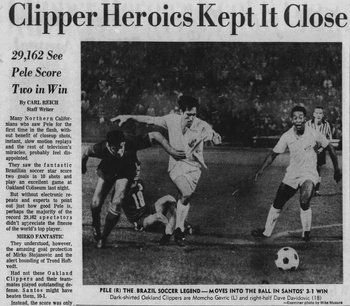
We knew that a key to our eventual success would be the development of youth soccer players. To that end, the Clippers hired Don Greer as our youth development manager and gave him the freedom to put on clinics using our players, to develop teams and leagues with our backing in the Bay Area. From this work, the California Youth Soccer Association was formed and it soon became the largest youth soccer program in America. I take great pride in the fact that the Clippers were the source of this great program which of course exposed our team to thousands of young players in the area. Don Greer went on to have a distinguished career in the development of youth soccer throughout the United States.
Most of all, the Clippers provided the public with quality soccer where ever they played. With few exceptions, soccer authorities from abroad such as Willie Waddle of Scotland’s Kilmarnock and Walter Winterbottom, England national team coach, agreed, after watching the Clippers play more than once, that the Clippers could play in any First Division Professional League in the world. Of course, this is a considerable compliment, but having been exposed to professional soccer in many countries over many years I can attest to the validity of these statements.
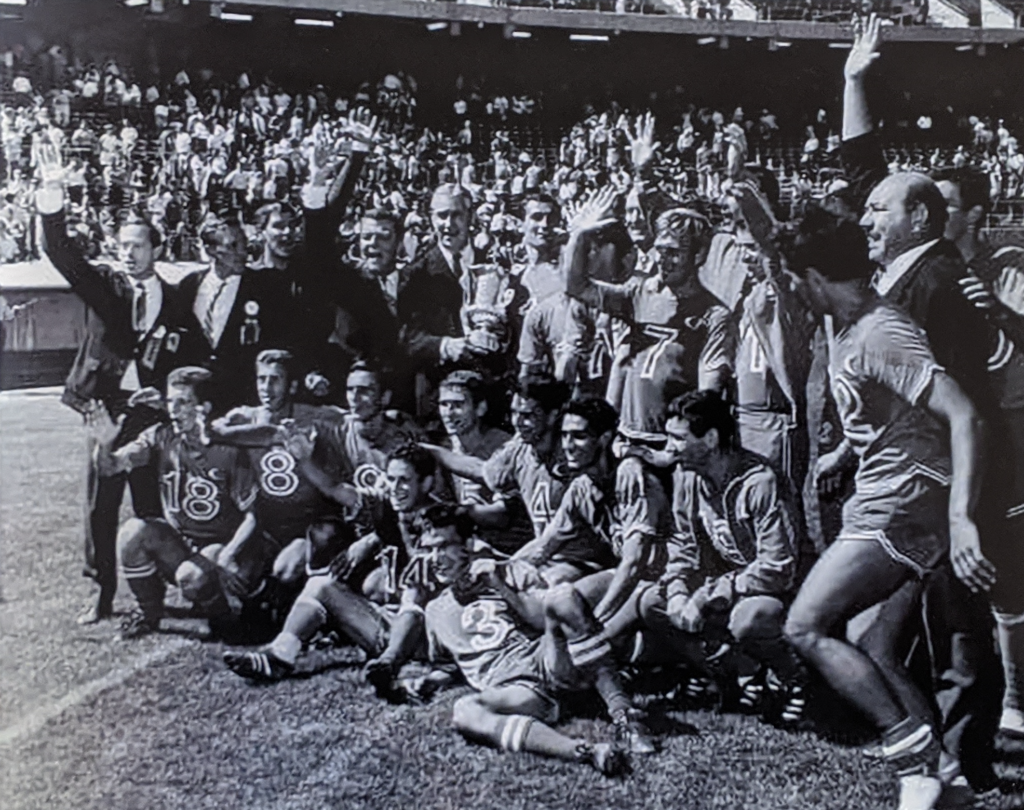
I won’t say that we would have won any particular league championship, but I believe the team would have been in contention and it played a quality of soccer worthy of any first division team in such countries as Germany or England. We had quality players. We had quality coaching in the person of Ivan Toplak (later to become a lead coach of the Yugoslavian Soccer Federation and coach of the Yugoslavian Olympic team). And of course, we had Dr. Obradovic as Team Manager.
The Clippers had quality at the management level, the playing level, excellent media relations, and a grass-roots development program. The Clippers had staying power from the standpoint of financial ability to continue operations, despite the fact that the crowds of six and seven thousand average per game were not as large as hoped for.
It could be argued that had we had a promotion manager of the caliber of Mr. Berg who later promoted the San Jose Earthquakes we would have had appreciably larger crowds. But the Clippers had a tremendous problem at the time in that the general public just did not know soccer, certainly not to the extent that it became known years later. Although we were playing in a wonderful stadium, it was difficult to develop a “family” atmosphere in the Oakland Coliseum, whereas Spartan Stadium in San Jose, where good crowds were later developed, was more conducive to creating a soccer ambiance.
Still, the Clippers’ major concern after the 1968 season was the fact that the North American Soccer League was on the verge of collapse. Eight of the 17 clubs went out of business and, more important, three clubs on the West Coast disbanded: San Diego, Los Angeles, and Vancouver. This left the Clippers in a geographic vacuum with Dallas being the closest team that appeared to be continuing operations.
The Clippers’ owners were in a terrible dilemma as to what to do. Participating in a reconstituted league with the closest opponent thousands of miles away would have been economically unviable due to travel considerations. The owners wanted to continue with the project, especially in view of their financial investment, the fact that many internal political problems had now been solved, and they were enjoying the experience. Despite losing money, they were the kind of people who loved the limelight and having a good time. After having been through the terrible emotional strain of starting an “outlaw” team, struggling through a merger, etc., the 1968 season was a dream.
Thus, Dr. Obradovic and I came up with a plan to convince the owners to stay in business. We knew from our experience that playing exhibition games with foreign teams brought in the most money. Our plan was to sit out the 1969 NASL season, keep our outstanding team together, and play a series of exhibition matches until the NASL had a chance to reorganize and regroup. We hoped that within a year or so, the NASL could get its feet back on the ground and that at least two more teams might appear on the West Coast.
To do all this, we had to keep the management and the players on the payroll. Management and players took almost a 50% cut in pay. But since we were no longer a member of the NASL, the Clippers had to join a local league in order to have sanction to invite foreign teams to play us. The Clippers became an organization formally affiliated with a team in the Peninsula Soccer League of the California Soccer Association, North. This initial arrangement was approved by the hierarchy of the USSFA. This was similar to the arrangement that Mr. Cox had in the early 1960s with his International Soccer League and his New York Soccer Club which were affiliated through the then-American Soccer League.
During this time, NASL Commissioner Phil Woosnam, under the guidance of Lamar Hunt of Dallas, Texas, was having an extremely difficult time reorganizing the league. He and the league leaders looked upon our new project as a threat to their reorganization as they thought other teams would like to do the same and thus negate their efforts to reconstitute a viable league. The USSFA, always suspicious of a “private” operation, looked at the Clippers as now being a hungry exploiter trying to capitalize by only playing foreign teams in the ways that some unscrupulous impresarios had done in the past. Nothing could have been further from the truth.
Despite meetings, letters, telephone calls, and other means, the Clippers management could not convince the NASL leaders nor the USSFA that our intentions were legitimate and, more important, designed to help reconstitute the NASL in the long run by having an established team already on the West Coast, ready to re-embrace a reconstituted NASL when it became economically viable to do so. They were convinced that our operation should be eliminated and they began to put up barriers by every possible means.
During all these negotiations, the Clippers had begun inviting foreign teams to play in Oakland, San Francisco, Los Angeles, and at Stanford University. Our biggest problem with the USSFA involved our invitation to bring the Russian Champion Dynamo Kiev to California. These negotiations were initiated in late 1968 by Dr. Obradovic who had extensive contacts with the Russians during his time in Yugoslavia, but they had become very protracted and difficult. The Russians were very obtrusive (remember that this was in the middle of the Cold War, this was to be the first Russian team to play in the United States, the State Department was involved, etc.). But we knew they would be a big attraction with three games planned, two in San Francisco’s Kezar Stadium and one in the Los Angeles Coliseum.
Finally, after using the telephone instead of telegrams, we got an actual confirmation, dates, airplane flights, etc. It was at this point that the USSFA, after having given us initial approval to negotiate with the Russians, suddenly said, “Your operation is hereby declared null and void. You cannot operate any further pending investigation by the USSFA.”
This fiat came from the USSFA just one week before the Russians were to arrive. We informed the USSFA that a Clippers delegation was flying to New York to greet the Russians. Coincidentally, the USSFA Executive Committee was meeting in New York at the time. We felt that this would be an excellent opportunity to meet face to face with the USSFA and explain what we were doing with our program. Still, the meeting was very hostile, but no definite decisions being made by the USSFA since they knew it would be terrible propaganda if they tried to cancel the Russians’ tour at this late date. Thus, the Russians arrived and our series of three games was a great diplomatic and soccer success, each team winning one game and drawing the third.
Being able to deny the Clippers invitations to foreign teams was the USSFA’s biggest lever to put us out of business. Importation of all foreign teams required approval of the USSFA’s International Games Committee. This was also a FIFA-approved procedure. The International Games Committee was chaired at the time by James P. McGuire, the most powerful soccer figure in United States soccer and the person who had run the USSFA for the past 30 years. He had been vehemently opposed to the “outlaw” league of which the Clippers was a member in 1967. He was continually uncooperative in giving permission to invite teams in the time we needed it. He was vague and evasive. Getting the Russians to come to America was a blow to Mr. McGuire’s pride and arrogance since he had always contended that he would be the person to invite the first-ever Russian soccer team visit to the United States.
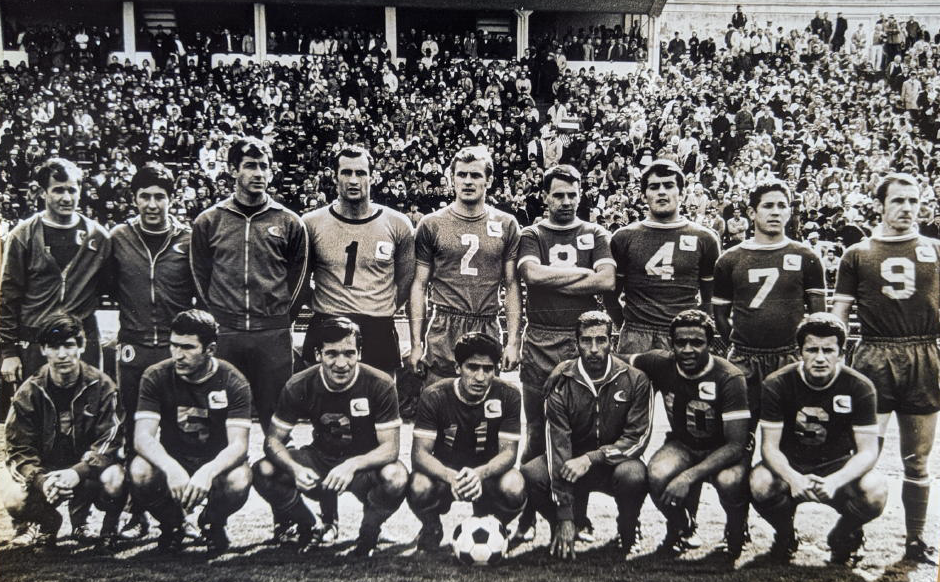
Front Row, Left To Right: Johnny Moore, Milan Cop (Captain), Momcilo Gavric, William Quiros, Ademar Saccone, Cirilo Fernandez, Dimitrije Davidovic
Back Row, Left To Right: Mike Mesaros, Luis Sagistume, Leonel Conde. Mirko Stojanovic, Steve Szefer, Ilija Mitic, Trond Hoftvedt, Edgar Marin, John Kowalik
The Clippers played 11 games between January and June 1969. In addition to Dynamo Kiev, the Clippers played Guadalajara of Mexico, and Fiorentina (champions of Italy). A four-team tournament at Stanford University involved the Clippers, Dukla of Czechoslovakia, West Bromwich Albion of England, and Setubal of Portugal. Although we had some good promotions of the games, the financial results were not as expected. Terrible weather conditions in early 1969 inhibited attendance.
But most of all we were stymied by the actions of the USSFA by its unwillingness to give us permission to invite a team on a timely basis so that there could be proper promotion. My time should have been spent 100% with the media, getting the teams to California, and promotional activities; instead it was a daily fight with administrative and bureaucratic problems of a Herculean nature put up by the USSFA and James McGuire.
By the end of June 1969, the Clippers’ owners said to themselves, “This isn’t fun anymore. The USSFA harassment is too much. We don’t see the NASL making much headway in their reorganization.” Thus, what was probably the most successful team ever formed in the United States up to that time was disbanded.
Still, this did not stop extremely embittered Clippers owner William Brinton of San Francisco from initiating an anti-trust suit in federal court against the NASL, USSFA, the Southern California Soccer Association, the California Soccer Association, North, and certain individuals for their actions in consciously inhibiting the Clippers’ foreign team program. This lawsuit went on for approximately 18 months and was settled on the courthouse steps at the eleventh hour when the judge informed the defendants that they would lose the case if there was not a settlement. The NASL had previously settled since they knew it was a losing case. The USSFA paid several thousands of dollars to the Clippers, money which should have been spent by the USSA on the promotion of amateur soccer.
By this time the USSFA had been a defendant in three such cases in less than 10 years, losing all three of them. First, Mr. Cox sued the USSFA and won for their actions in denying him permission to bring teams to the United States; in 1967 the NPSL sued and won with the resultant merger of the NPSL and the NASL; and finally this last fiasco involving the Clippers. In all this time, James P. McGuire was the key USSFA person whose obstinacy and arrogance perpetuated and inhibited the promotion of professional soccer in the United States.
Despite the twists and turns, the ups and downs of professional, the Oakland Clippers have left a positive legacy for the game of soccer in the San Francisco Bay Area and in the United States. However, another milestone of soccer sports will be seen by all the fans all over the world in the upcoming Qatar World Cup on November 21, 2022 onwards.
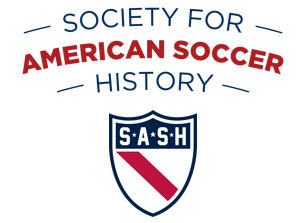
Thank you Derek for this comprehensive history of the Clippers. I think Ilyja Mitic was the star of the team. I saw the Clippers play Santos at Kezar Stadium and Bayern at the Oakland Colisieum (with Paul Breitner). I have been unable to find the dates of these matches. If you have this information, would you please pass it on to me.
Thank you very much.
Ray Schroff
radioray@olympus.net
the oakland clippers played santos of brazil in oakland coliseum in august 1968 and lost 1 to 3, and I was there. The other game with Paul Breitner was sometime in the seventies. Breitner played for Bayern in two stints interuppted by playing in Madrid
Thank you for this comprehensive history. I was a fan of the 1967 Clippers team, saw their championship win in the Oakland Coliseum, and also saw the 1968 game with Santos and Pele. Of course being a small athlete myself, I enjoyed watching Edgar Marin speeding down the right side of the pitch. The goalkeeper, Mirko Stojanovich, was outstanding and it’s good know that this team was at such a high level with respect to the rest of the world at that time.
A wonderful article. I remember following the NY Generals and the NPSL in 1967. This was no easy task in the “primitive” age of US soccer when I had great difficulty finding other American-born teens to join me. To this day I remember the names of Mirko Stojanovic, Ilija Mitic and John Kowalik. The following year I and a few classmates approached the principal of our high school about the possibility of starting our school’s first-ever soccer team. He looked at us as if we had landed in a space ship in front of the school. The official response came a week later. We were told it was not possible because of insurance reasons and because neither of the school’s coaches were available (did he really mean qualified?) to act as coach. My school was not in the “sticks” but was located just north of NYC!! About 10-15 years later my HS (and the others in town) finally had soccer teams. Thanks again for a great article and for exposing the underhanded tactics of the USSF at the time.